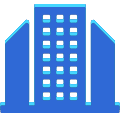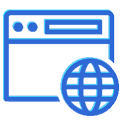Ionic is an open-source software development kit used for the development of hybrid mobile applications for cross-platform users. Initially, it was built on AngularJs and Apache Cordova. It is a drag and drop interface building tool. It is the development tool for designing applications faster than ever for all kinds of cross-platform uses. It lets Ionic developers build apps in one codebase thus letting them go for faster design, testing, and launching. It has a real-time monitoring facility helping to push app updates and bug fixes faster to users without the need for an app store as intermediate. Lots of big companies around the world like Verizon, EA games, IBM, Comcast, and many others use Ionic for their application development needs & hire dedicated Ionic developers from USA, UK. Germany & India.
Ionic App Development Services - Hybrid Mobile App Development with Ionic
IONIC is the Best Platform for Mobile Hybrid App Development. And, We provide Best Ionic Application Development Services at CoreApps Tech.
CoreApps Tech is the most reputed name of the company who is offering Best Ionic development services comes under the category of Hybrid app development. As we all aware that Ionic is an open source framework that is being used to develop extensively interactive hybrid apps for various platforms such as Android, Windows, iOs etc.
Ionic app framework development or, Ionic framework development, covers the power of Angularjs, HTML5, and CSS that helps to boost up its performance and also make it more responsive and user-friendly. The need of Ionic Development companies for modern multi-featured best mobile apps development is being increased day by day. Because, Ionic mobile development adds most advanced features in the mobile app development, easy code maintenance, multi-device resolution with browser compatibility and high level of security. We at CoreApps Tech offers front end feature rich hybrid mobile app development services on the Ionic platform for Android, iOS, Windows mobile operating systems.
Hire Ionic Developer - Ionic App Developers in USA, UK, Germany & India
At CoreApps Tech, we offer cost-effective high featured Ionic mobile app development services, we are having an extensively skilled and professional team of Ionic developers who are always motivated to adopt latest technologies and passionate in ionic coding to developing the best mobile applications that perfectly fit to the need of our business requirements. If you are looking to hire ionic developer then, we're the Best here among Top companies to serve your queries for mobile app development with ionic 2 framework.
Our Ionic app development Company provide the beautiful and appealing mobile app development services with top facilities, our expert ionic app developers are enough sufficient to use latest technologies like HTML5, Angular JS, etc. to develop up-to-date integrated seamless apps that are multi-functional features that perfectly suit your business.
Why Ionic is considered over other options for mobile app development?
Ionic allows developers to utilize the easy and fast software development kit to make truly cross-platform applications in very less time. The apps designed can directly be deployed into devices without the use of an app store. Since the platform uses software like CSS, HTML 5, Sass and Java, programmers with specials skills are not required for the development, existing development teams can use and create the same applications in the Ionic software development kit faster than in other platforms. The high cost of hiring native developers are also avoided by using existing development teams.
Ionic uses Cordova Plugins that gives access to host users' operating system features. By using angular the platform allows various ways of interacting with these components. It has tools inbuilt to help build applications in a user-friendly manner. These features are brought about by using CSS, HTML 5 and Java. Offering not just the open source tools, it gives access to Ionic app flow cloud features. Maintenance of the application is not required due to the use of Angular. The code can be sent to app stores directly without any platform dependencies or complicated steps before delivering to different Operating systems like IOS, Android or Windows.
Error monitoring and application tracking in realtime to avoid users from spotting errors in the built application using Ionic development services. The errors can be rectified and the applications can be directly updated to users without the use of an app store.
Ionic is built for the future of application development. It lets the developer use React, Angular or any other front-end software development platform for the development of the applications.
Supported platforms for Ionic App Development services
Ionic is focused on modern application development, so it has support for most mobile Operating systems. It works with Android, IOS, Windows and even Blackberry.
- In Android, Ionic support for apps from Android 4.1 and above. In IOS support is available for IOS 7 and above.
- Ionic 2 (2nd version of Ionic) supports application building in the universal windows platform for building apps in windows 10.
- Blackberry 10 OS applications can also be built in Ionic using mobile node.js.
- Ionic is an npm module and thus requires Node.js installed.
Guide to the Ionic Framework for Ionic App Development Services
Now we come to the main point of discussion about the guide to Ionic Framework which we will be discussing for Ionic app development & Ionic development services:
Some of the common features or major features of the IONIC framework are as follows:-
- Provides excellent codebase provision for the development of the app
- Regarding the performance of the Ionic, it provides limited performance and the rating is also not so good
- It can be built app only when it is wrapped with a native variable so the look of the app will not so be good
- Regarding testing Ionic provides good testing facilities
- Ionic provides an affordable range of price for the development of app or applications.
The Big Three Angular, React and Node is rightly ruling the current market. AngularJs is the most popular JavaScript framework, which is being used asAngularJS development. ReactJs is for ReactJS development and Vue is also expected to continue as the development tools in 2019. Ionic V4 or Ionic 4.0 has been exclusively Angular compatible and thus supports many versions of VUE. It is an asynchronous process and thus it takes too much time to load in a common device. Ionic V4 property is also helping the language to develop or grow or progress day by day in the international markets.
Cross platform development makes significant gains due to which the percentage of developers has been reduced from 52 percent to about 8 percent in the last few years of business or marketing. Frameworks which are commonly known such as Ionic, React JS or React Native applications are actually the evolutions of progressive web applications. Because of this, People moving to PWA development services rapidly by choosing Best Progressive web apps development company. Thus due to these reasons, they plan to build one this year a similar program, which will continue the same of data from the user access protocol or prototype. Consumers are also getting trained for consecutive app store program resource which is helping quite a lot to everybody.
Let's discuss about Different Ionic Versions
IONIC 2 - IONIC VERSION 2 FRAMEWORK
First of all, let us know about the term ionic. Ionic is an open source software development kit (SDK). It is a basic structure that underlying the system for building hybrid mobile apps especially for Android, IOS, and any other windows platforms.
Ionic can use standard web technologies that is if we have command on HTML, CSS, SASS, JS we can build a single app. By Ionic, we are able to make people’s attention towards the native functionality of the target device platform. We can use ionic to build hybrid mobile apps that are accessible just like other apps in the app store. We can download the apps and are accessible to the phone.
Ionic 2 or, 2.0 is on trend because it helps in better learning online. We should have good command on HTML which helps us in building HTML pages. DOM and HTML determine the structure of the page. Familiar with CSS and browser prefix for CSS rules. On the other hand, if you have better knowledge about JAVA you can develop the ionic app in a better and easy way.
For installation of ionic version 2, we need node js 6. For the installation process visit installation page and choose installer based on your OS. We need to make npm that is Node Package Manager that is included with an installer. In the installation process, it is on the last screen of Node js 6. After that, you can proceed to further steps.
The next step before starting your first ionic project is that you have a better console mostly cmder for using ionic version 2 in the best way. Cmder is an amazing software having the monokai color scheme and custom prompt layout. On the console window, type “$ npm install – g ionic Cordova”. The –g command stands for a (global) flag. The command “$ npm install – g ionic Cordova” is needed to run only once on your machine. It installs ionic CLI (command line interface) along with Cordova. After that, your app is developed natively and you can start your first ionic project.
Don’t worry about how to start your project, what is basics of starting?
First of all, you have to write the command “ionic start first project blank –v2”. In this command, the “ionic” helps you to access ionic CLI and issue to it certain commands. For the version information type “ionic” and press the enter button, you will also get knowledge about available commands.
For descriptions of each command you should type “ionic –h”, it will also help by giving arguments of each command. “start” in the given command help us to start the new project. “first project” in the given command is the path and we can change the name according to our topic. The CLI plays the best role in it because ionic CLI create a folder with the name of the path, and placed inside of it all necessary project files and folders. “blank” is an optional command.
Based on the project needs ionic 2 provide several different templates while tabs, and tutorial. “--v2” command states for the version of ionic, if this command is absent than project of ionic version 1 will be install. But in present time, --v1 and –v2 both are not supported in the new version of ionic. Just create your project. Once the command is completed the next command will be “$ cd first project” that indicates your first project is ready.
After that run “$ ionic serve” command in a first project folder. The command is useful because it helps in creating a local development server that helps us to preview the app in a browser file. By this command, we can find launch the project automatically. The term “ionic serve” boosts up a development server on all network interfaces and print external addresses.
Ionic serve accepts another option. Type “ionic –h” in a console. The term “port” when omitted the default port is 8100 and allows us to designate the dev port. Another term is “browser”, it is your choice to choose safari, firefox or chrome. “--lab” we also notice another form of the term “-l”, allows you to view the app on simulating mobile platforms and screen sizes at the same time. “platform” that is IOS or Android. “--nolivereload” when we save the files it will automatically reload browser after running ionic serve. Press control c and type y for yes we can exit out of ionic serve. Next type “$ ionic serve -1” to serve the app in lab mode size.
The ionic version 2 structure will look alike angular 2 project structure. Angular 2 is another software to develop the apps which structure is quite different from the ionic version 2 structure. Your work in ionic version 2 is in /src folder. The important difference between ionic version 2 and angular 2 is that we use SASS file instead of a CSS file. SASS is used when ionic CLI generates a new project.
Migrating from Ionic 1.0, 2.0 & Ionic 3.0 to Ionic 4.0 - A Complete
Guide by Ionic App Development Company
WHY AN IONIC DEVELOPER MUST MIGRATE THE APPLICATIONS TO IONIC 4 FROM PREVIOUS VERSIONS DURING IONIC APP DEVELOPMENT?
As we already know that Ionic is a free and open-source software development kit developed by Max Lynch, Ben Sperry and Adam Bradley. In 2013, the developers at Drifty co. released Ionic and the framework was built using JavaScript. Initially, the software development kit was built on Apache Cordova and Angularjs. With the upcoming updates, Ionic has become one of the most used app development tools for Ionic mobile app development. It is used for making mobile apps, web apps and also progressive web apps by Ionic app development companies. By hiring Ionic developers, The apps made using Ionic are developed very fast and also with better efficiency.
This is due to the tools and functions that the Ionic platform provides to make the user interface with ease while also making it highly immersive. Ionic development services are used for building highly interactive mobile applications that work in all the major platforms using common web technologies like CSS, HTML 5, SASS, etc. The Hybrid mobile app development with ionic apps are created using web technologies and then can be pushed to respective app stores by leveraging the use of Cordova. It is a simple drag and drop interface building tool which can be used to make complex user interfaces with ease.
Due to its association with Angular, Ionic has been gaining a lot of popularity among developers. So with improvements coming in Angular, Ionic also has let out corresponding updates in its framework for improving the performance in an efficient manner. The new Ionic framework is built completely from scratch making it compatible with not just Angular, which was the primarily associated framework for doing Mobile app development with ionic.
The ionic framework can be integrated with almost any JavaScript framework like Vue, React, etc. or any other future frameworks that come up. The version 4.0 of Ionic is named as Ionic Neutronium, the imaginary element before hydrogen in the periodic table. The future updates released will be named after the elements as Ionic 4.1 hydrogen, Ionic 4.2 lithium and so on.
LET US TALK ABOUT THE DIFFERENCES THAT ARE PREDOMINANT BETWEEN IONIC 3 (VERSION 3) AND IONIC 4 (VERSION 4) TO UNDERSTAND WHY DEVELOPERS NEED TO MAKE CHANGES TO THE APPLICATION AND ADOPT USING IONIC 4 FOR THEIR MOBILE APPLICATION DEVELOPMENT!
The main advantage of using the latest version 4 of Ionic for development is that there are a lot of updates corresponding to the improvement of performance and the capabilities of the framework. The new documentation brings up better build time capabilities for the developers. A very important change in the new version is the added support for other JavaScript based frameworks like Vue, React, etc. which did not have the capability to integrate with Ionic components. This means the Ionic mobile app development company & developers can choose any framework to work on and integrate it with the Ionic components with ease.
Although all frameworks are supported, Angular being the framework with support from the beginning has got more advantages. With this feature, Ionic has achieved its initial goal of being a complete UI library with support for almost all JavaScript frameworks or tools and assist in making Ionic application development. The ability to make use of modern web API's is a feature that the Ionic cross-platform development team has brought about in the latest version.
This, in turn, allows the use of custom elements, variables in CSS and also lets the user utilize the shadow DOM for the application. This was achieved by doing a complete rewrite of the core code of the framework which makes all components developed using Ionic as web components by making complete use of the modern web API's. These Ionic web components can be used by any Ionic development company & Ionic framework in the HTML segment as the component is viewed by the browser as a recognized HTML element.
These Ionic components can also be used without any framework as they are web components. For Ionic developers using Angular, there is not much difference in the integration of Ionic components in the application development. The use of tooling and command line interface of the framework that Ionic is integrated to by the Ionic developer, allows for complete utilization of the advantages of both Ionic and the other frameworks CLI. This means that the Ionic mobile developer can make of Ionic CLI when and where required and there need not be separate updates from the framework to support new changes in Ionic tooling.
This lets the Ionic app developer choose the framework that is more comfortable to use based on the requirements of the application that is to be developed. Ionic 3 had a lot of updates for routing and CLI which brought about a lot confusion and framework churn which is heavily avoided due to the better use of CLI of both the worlds in the latest version. The process of updating to version 4 is also made very easy for the Ionic developers. The added advantage is that there will not be much change to the core framework so updating to future releases of Ionic will be easier.
The web component building tool stencil is another new introduction in Ionic version 4. It helps in reducing the code and puts the load on the browser to utilize the web components. This lets Ionic mobile app developers make applications with faster load times while also provide better support Progressive web applications that are regarded as the future of application development. Ionic icons are also a new feature that is introduced in version 4.
They are custom icons that are developed by the Ionic framework developers for use in applications. They can be used by developers to make their applications more interactive and in turn, making the apps to provide a better user experience.
THERE ARE MORE FEATURES IN THE NEW VERSION BUT THIS IS ENOUGH TO UNDERSTAND THE BASIC DIFFERENCES AND SO WE WILL DISCUSS HOW TO MIGRATE APPS FROM IONIC 3 TO IONIC 4.
The applications that were made using Ionic version 3 do not require as much work as migrating form Ionic version 1 which essentially used Angular 1 or Angular js. It is because there are a lot of changes in architecture, routing, navigation and also there are a lot of new feature differences from Angular 1 to Angular 7. Not just in Angular but there are also many differences between the latest Ionic framework and Ionic 2 using Ionic 2 development.
So to begin with the migration of the app from Ionic 3 to Ionic 4, a good understanding of the changes brought about in the Angular version is necessary and can be easily found in Angular's release guide. To begin the migration, the developer must start a new Ionic 4 project. Then, step by step parts of the Angular code needs to be copied into the project. The Ionic app development services, pipes, and all the other essential components need to be copied one feature at a time. The features must be tested side by side while copying into the project for better efficiency.
As Ionic 4 has the support to use Angular routing and navigation, the use of Ionic's Navcontroller is not necessary. This lets us embrace the tooling of any framework that is used for building the application to achieve a better routing experience due to the changes in navigation, the lazy loading feature also has changed to it.
It is easy to update changes for using the new lazy loading by using Angular's Load children method. Complete guides to change over from Ionic version 3 to version 4 starting from updating the framework to app migration can be looked up at the Ionic framework website in case of any doubts.
LET US NOW SEE WHY A DEVELOPER MUST MIGRATE THEIR APPLICATION BUILT ON IONIC 1? WE WILL LOOK INTO THE CHANGES THAT WERE BROUGHT ABOUT FROM IONIC 1 TO IONIC 2.
There was a lot of change from Ionic 1 to Ionic 2 when compared to any other version changes in Ionic. This is because of the framework Angular which was chosen to support Ionic for building platform-independent applications had a complete rewrite in its core code. The major changes were related to the performance of the Ionic framework.
Ionic 2 was faster than Ionic 1 in many ways. Firstly components were brought into use in Ionic 2 for the Ionic mobile development. The changes in the state of model brought about were updated only to the components responsible for the view rather than using a controller to update the entire component tree. This was achieved by adopting a one-way binding of the data over the previously used two-way binding.
As the app grew complex, the two way binding of data proved to slow down the application thus leading to the change to one-way binding. The introduction of the new compiler in Angular, the ahead of time compiler made a lot of difference in the performance. The template rendering speeds of Angular 2 were very fast when compared to that of Angular Js.
The Ionic 2 framework was also made with support for progressive web applications which made the framework more advantageous. Once code could be used for both mobile applications and also for web apps during Ionic development. The change in scripting language from JavaScript to Typescript was also another major change observed but the existing functions did not actually change while new functions and tools were added to it.
NOW, WE WILL SEE HOW TO MIGRATE YOUR APPLICATION FROM IONIC 1 TO IONIC 2?
The developer must first generate a new Ionic 2 application for migrating the application while doing Android app development using ionic. The new application must contain a component for each feature the old application had. The code from the Ionic one application needs to be copied into the newly generated application. Not all the code is copied, the code in the controllers and services are to be copied into each components class definition.
The code is copied one component at a time and the syntax might actually vary and so some changes are to be made before copying. The templates are also copied and put into the new application. Similar to the components, the syntax changes are first made to the code corresponding to the templates.
A few things like Navigation and routing are completely different between the two versions and require better understanding to work on. The Ionic app can directly be updated to Ionic 4 but that requires a lot of changes and less reuse of existing app code.
FROM HERE A TS LINT FIXER CAN BE USED TO UPGRADE THE APP TO IONIC VERSION 4
This method is not only for converting for migrating an app from Ionic 2, but the applications made using Ionic 3 can also be migrated to Ionic 4 but the fixers used would be different in each case. The first step of this process would be to update the Ionic framework to the latest version and try to compile the application code.
There will be a series of errors due to the changes in the new framework. The Ionic app developer must then install the rule set for the migration process. The rule set contains a lot of rules, where each rule is for a specified target. Then the analyzer should be run to see the changes that are to be made to the code. The analyzer has inbuilt fixers which change most of the required code based on the new version syntax. The tool cannot perform all the changes required but does most of the work and thus simplifies the process of migration of the application.
For example, if an element is selected, the entire DOM tree is searched for the element and when the matching attribute is found, the contents of the element is extracted and then replaced with a new element with the contents of the old element. There are limitations to using this tool for migration but the process is easier when done using TS lint.
OVERVIEW OF MIGRATING FROM IONIC 1.0 & IONIC 3.0 TO IONIC 4.0
The newer versions might have a lot of new features, better performance and also facilitate easier app building but the app built on the older version could be very stable. So the decision of whether or not to migrate the application to the new version of the Ionic framework is to be done by the developer. So, Hire Ionic developers now from CoreAppsTech! But not updating for a long time could become very disadvantageous.
Advantages of using Ionic Development Tools by the skilled Ionic Developers
Being a truly cross-platform software development tool, development of an application is done only once and the app can be pushed for use in Android, IOS and Windows directly without any need for changing code for specific devices. Allows the use of any front end management tools according to the user's choice for comfortable development.
The software development tool is built on Angular and Cordova and coding is done by using HTML 5, JAVA, CSS enabling companies to use their existing developers to build faster applications for their use rather than hiring expensive native developers.
As the framework runs by using these platforms that are common among developers making the development very fast and the cost of development is also reduced greatly. These use of these components also make it need very less maintenance. Performance of the developed applications is also better when native applications are mixed with Ionic code. Angularjs allows the programs built on Ionic to rely on native hardware acceleration to improve performance.
Use of CSS transitions for animations make the system make full use of the GPU and fully use the available processor time. This open-source cross-platform Software development kit is also found very useful because of the use of Cordova plugins which can access the operating system features of the device like a camera, GPS, etc.
Angular provides a lot of methods for different components to interact with these plugins. Easy app sharing and continuous app monitoring help in getting feedback on new updates of features integrated into the applications. Continuous monitoring also enables the developer to maintain the quality of the application by finding errors before the users. Automatic builds help in testing, running and deploying the program code each time a member updates the code. These updates can be directly sent to the users rather than pushing it through app stores to speed up the process of removing bugs before the users notice or also apply new features through it.
Secure collaboration between teams can be made easier by using shared dashboards to keep different teams informed about updates. Permissions can be used to safeguard the core code by giving only required members permission to work on the application's code. Thus Ionic can be used for creating robust and interactive cross-platform mobile apps with ease, the speed of development is also very quick.
Now we are going to discuss the advantages of using Ionic for developing various sorts or types of apps. Some of the advantages are as follows:-
- The Ionic allows the developer to work with the technologies of web browser application protocol which will enhance the better performance of the application. Therefore if a developer is skilled in making apps using web technologies then he or she will not take too much time to build a react native app and thus no valuable time or money will be lost.
- The Ionic is not totally dependent on cross-platform and thus the maintenance cost of the app is much cheaper since the developer does not have to build another app and thus it saves much valuable time and valuable money and thus due to this reason the companies of today’s world are preferring it.
- This is one of the major sources for all the supported platforms or multiple support based programming language.
- The main development in CSS and javascript which almost all web developers know and thus developers prefer to use this framework.
- And being able to use great frameworks like angular which is embedded in ionic by default the developers, as well as the companies, are adopting this framework.
- The development time, as well as the development cost of the ionic app development, is too short and so due to this reason ionic is highly growing in the market place and developers are also adopting them.
Although using Ionic for development is very advantageous in many ways, it does have some problems like any other platform available in the market today. Ionic is a great choice for building apps with native functionalities to run on multiple devices with just a one-time coding facility. Some developers consider using native means for developing apps specific to an operating system because of the diversity in the performance and flawless functionalities of the native features. So whether the applications require a multi-platform functioning and require real-time deployment with quick performance speeds at almost the same cost of development as other methods of app development is necessary for deciding which platform to use for your app development needs.

























